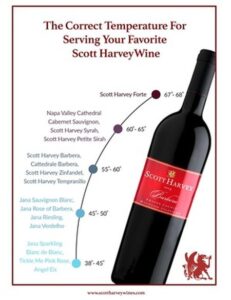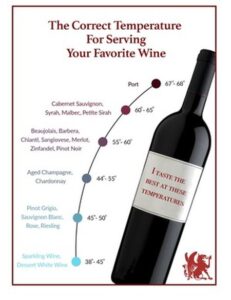Many diners at not-so-great restaurants or outdoor activities have experienced red wine served too warm, almost hot. Whether the cause was due to proximity to the oven or exposure to the sun, those wines simply didn’t taste as expected nor offered any suggestion of refreshment.
To be fully appreciated, each wine expresses its truest, best flavors and style when served within a specific temperature range. The best wine tasting experiences at the better wineries will always strive to serve the wines at their optimal temperatures.
 Best Temperature for Serving Red Wines
Best Temperature for Serving Red Wines
An old adage suggests that red wines are best served at “room temperature.”
In truth, room temperatures today, with controllable air conditioning and heat, tend to be in the 70°F and higher range, much too warm for good, or even average, red wine to exhibit its best qualities.
So, while “room temperature” may be an inexact designation, experts agree that full-bodied red varietals and blends are best served within a range of 59° to 64°F.
What if the red wine is served too cold?
If the wines are served at a colder temperature, the flavor becomes thinner and perhaps too harsh, having lost some of its acidity and fruit structure. Note that the best way to warm the wine is to rub the bowl of the glass with your hands, gradually raising the temperature to a more acceptable level.
Should your red wine be served at a notably warmer temperature than ideal, the drinker will taste mainly the alcohol and excess bitterness.
It should also be noted that exposing any wine to warm or hot temperatures for an extended period, as when left in an automobile on a hot day, will result in a permanently damaged, tainted product.
Best Temperature For Serving White, Sparkling, and Rosé Wines
In most better restaurants, white wines will arrive at the table with an ice bucket to maintain a cooler temperature. While not all whites, sparkling wines, or rosé wines should be served at the same temperature, WineFolly suggests that most should be kept in a range of 49° to 55°, somewhat warmer than the typical refrigerator.
Long-Term Storage
Storing wines for long periods requires an environment that will maintain cool, constant temperatures between 50° and 59°F without any exposure to bright light. In past centuries, caves and caverns served to provide the ideal environment. Many of these are still in service today, supplemented by man-made, temperature-controlled cellars.
Bottles with corks should be positioned horizontally to prevent the stopper from drying out. Most purposed designed wine racks will angle the bottle appropriately.
Screwcaps are becoming more common even with better wines and may be stored vertically, although the constant and cool temperature is still essential.
Best Winetasting at the Scott Harvey Winery Tasting Room
Learn more about the art of winemaking and the proper handling and serving of wines by visiting the Scott Harvey Winery Tasting Room in Amador County in Plymouth, California.
Visit the Scott Harvey Winery website to learn more about this award-winning winery founded and operated by Scott and Jana Harvey, long-time Napa Valley wine veterans. While at the website, you can reserve the most enjoyable, informative, and best winetasting experiences anywhere.
